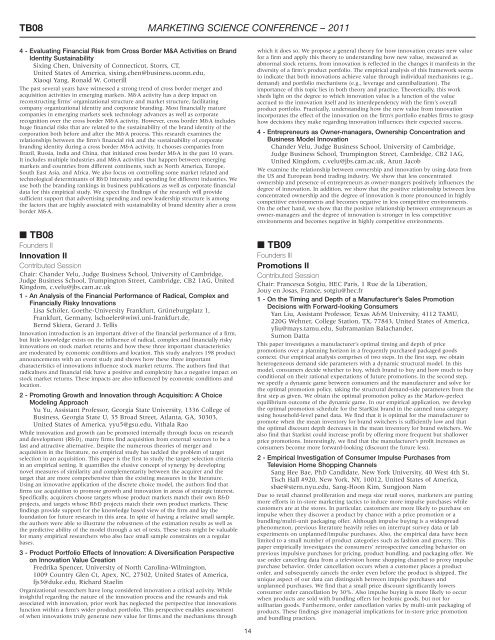Conference Sessions - Jesse H. Jones Graduate School of ...
Conference Sessions - Jesse H. Jones Graduate School of ...
Conference Sessions - Jesse H. Jones Graduate School of ...
Create successful ePaper yourself
Turn your PDF publications into a flip-book with our unique Google optimized e-Paper software.
TB08<br />
4 - Evaluating Financial Risk from Cross Border M&A Activities on Brand<br />
Identity Sustainability<br />
Sixing Chen, University <strong>of</strong> Connecticut, Storrs, CT,<br />
United States <strong>of</strong> America, sixing.chen@business.uconn.edu,<br />
Xiaoqi Yang, Ronald W. Cotterill<br />
The past several years have witnessed a strong trend <strong>of</strong> cross border merger and<br />
acquisition activities in emerging markets. M&A activity has a deep impact on<br />
reconstructing firms’ organizational structure and market structure, facilitating<br />
company organizational identity and corporate branding. Most financially mature<br />
companies in emerging markets seek technology advances as well as corporate<br />
recognition over the cross border M&A activity. However, cross border M&A includes<br />
huge financial risks that are related to the sustainability <strong>of</strong> the brand identity <strong>of</strong> the<br />
corporation both before and after the M&A process. This research examines the<br />
relationships between the firm’s financial risk and the sustainability <strong>of</strong> corporate<br />
branding identity during a cross border M&A activity. It chooses companies from<br />
Brazil, Russia, India and China, that initiated cross border M&A in the past 10 years.<br />
It includes multiple industries and M&A activities that happen between emerging<br />
markets and countries from different continents, such as North America, Europe,<br />
South East Asia, and Africa. We also focus on controlling some market related and<br />
technological determinants <strong>of</strong> R&D intensity and spending for different industries. We<br />
use both the branding rankings in business publications as well as corporate financial<br />
data for this empirical study. We expect the findings <strong>of</strong> the research will provide<br />
sufficient support that advertising spending and new leadership structure is among<br />
the factors that are highly associated with sustainability <strong>of</strong> brand identity after a cross<br />
border M&A.<br />
■ TB08<br />
Founders II<br />
Innovation II<br />
Contributed Session<br />
Chair: Chander Velu, Judge Business <strong>School</strong>, University <strong>of</strong> Cambridge,<br />
Judge Business <strong>School</strong>, Trumpington Street, Cambridge, CB2 1AG, United<br />
Kingdom, c.velu@jbs.cam.ac.uk<br />
1 - An Analysis <strong>of</strong> the Financial Performance <strong>of</strong> Radical, Complex and<br />
Financially Risky Innovations<br />
Lisa Schöler, Goethe-University Frankfurt, Grüneburgplatz 1,<br />
Frankfurt, Germany, lschoeler@wiwi.uni-frankfurt.de,<br />
Bernd Skiera, Gerard J. Tellis<br />
Innovation introduction is an important driver <strong>of</strong> the financial performance <strong>of</strong> a firm,<br />
but little knowledge exists on the influence <strong>of</strong> radical, complex and financially risky<br />
innovations on stock market returns and how these three important characteristics<br />
are moderated by economic conditions and location. This study analyzes 198 product<br />
announcements with an event study and shows how these three important<br />
characteristics <strong>of</strong> innovations influence stock market returns. The authors find that<br />
radicalness and financial risk have a positive and complexity has a negative impact on<br />
stock market returns. These impacts are also influenced by economic conditions and<br />
location.<br />
2 - Promoting Growth and Innovation through Acquisition: A Choice<br />
Modeling Approach<br />
Yu Yu, Assistant Pr<strong>of</strong>essor, Georgia State University, 1336 College <strong>of</strong><br />
Business, Georgia State U, 35 Broad Street, Atlanta, GA, 30303,<br />
United States <strong>of</strong> America, yyu5@gsu.edu, Vithala Rao<br />
While innovation and growth can be promoted internally through focus on research<br />
and development (R&D), many firms find acquisition from external sources to be a<br />
fast and attractive alternative. Despite the numerous theories <strong>of</strong> merger and<br />
acquisition in the literature, no empirical study has tackled the problem <strong>of</strong> target<br />
selection in an acquisition. This paper is the first to study the target selection criteria<br />
in an empirical setting. It quantifies the elusive concept <strong>of</strong> synergy by developing<br />
novel measures <strong>of</strong> similarity and complementarity between the acquirer and the<br />
target that are more comprehensive than the existing measures in the literature.<br />
Using an innovative application <strong>of</strong> the discrete choice model, the authors find that<br />
firms use acquisition to promote growth and innovation in areas <strong>of</strong> strategic interest.<br />
Specifically, acquirers choose targets whose product markets match their own R&D<br />
projects, and targets whose R&D projects match their own product markets. These<br />
findings provide support for the knowledge based view <strong>of</strong> the firm and lay the<br />
foundation for future research in this area. In spite <strong>of</strong> having a relative small sample,<br />
the authors were able to illustrate the robustness <strong>of</strong> the estimation results as well as<br />
the predictive ability <strong>of</strong> the model through a set <strong>of</strong> tests. These tests might be valuable<br />
for many empirical researchers who also face small sample constraints on a regular<br />
bases.<br />
3 - Product Portfolio Effects <strong>of</strong> Innovation: A Diversification Perspective<br />
on Innovation Value Creation<br />
Fredrika Spencer, University <strong>of</strong> North Carolina-Wilmington,<br />
1009 Country Glen Ct, Apex, NC, 27502, United States <strong>of</strong> America,<br />
fjs3@duke.edu, Richard Staelin<br />
Organizational researchers have long considered innovation a critical activity. While<br />
insightful regarding the nature <strong>of</strong> the innovation process and the rewards and risk<br />
associated with innovation, prior work has neglected the perspective that innovations<br />
function within a firm’s wider product portfolio. This perspective enables assessment<br />
<strong>of</strong> when innovations truly generate new value for firms and the mechanisms through<br />
MARKETING SCIENCE CONFERENCE – 2011<br />
14<br />
which it does so. We propose a general theory for how innovation creates new value<br />
for a firm and apply this theory to understanding how new value, measured as<br />
abnormal stock returns, from innovation is reflected in the changes it manifests in the<br />
diversity <strong>of</strong> a firm’s product portfolio. The empirical analysis <strong>of</strong> this framework seems<br />
to indicate that both innovations achieve value through individual mechanisms (e.g.,<br />
demand) and portfolio mechanisms (e.g., leverage and cannibalization). The<br />
importance <strong>of</strong> this topic lies in both theory and practice. Theoretically, this work<br />
sheds light on the degree to which innovation value is a function <strong>of</strong> the value<br />
accrued to the innovation itself and its interdependency with the firm’s overall<br />
product portfolio. Practically, understanding how the new value from innovation<br />
incorporates the effect <strong>of</strong> the innovation on the firm’s portfolio enables firms to grasp<br />
how decisions they make regarding innovation influences their expected success.<br />
4 - Entrepreneurs as Owner-managers, Ownership Concentration and<br />
Business Model Innovation<br />
Chander Velu, Judge Business <strong>School</strong>, University <strong>of</strong> Cambridge,<br />
Judge Business <strong>School</strong>, Trumpington Street, Cambridge, CB2 1AG,<br />
United Kingdom, c.velu@jbs.cam.ac.uk, Arun Jacob<br />
We examine the relationship between ownership and innovation by using data from<br />
the US and European bond trading industry. We show that less concentrated<br />
ownership and presence <strong>of</strong> entrepreneurs as owner-mangers positively influences the<br />
degree <strong>of</strong> innovation. In addition, we show that the positive relationship between less<br />
concentrated ownership and the degree <strong>of</strong> innovation is more pronounced in highly<br />
competitive environments and becomes negative in less competitive environments.<br />
On the other hand, we show that the positive relationship between entrepreneurs as<br />
owner-managers and the degree <strong>of</strong> innovation is stronger in less competitive<br />
environments and becomes negative in highly competitive environments.<br />
■ TB09<br />
Founders III<br />
Promotions II<br />
Contributed Session<br />
Chair: Francesca Sotgiu, HEC Paris, 1 Rue de la Liberation,<br />
Jouy en Josas, France, sotgiu@hec.fr<br />
1 - On the Timing and Depth <strong>of</strong> a Manufacturer’s Sales Promotion<br />
Decisions with Forward-looking Consumers<br />
Yan Liu, Assistant Pr<strong>of</strong>essor, Texas A&M University, 4112 TAMU,<br />
220G Wehner, College Station, TX, 77843, United States <strong>of</strong> America,<br />
yliu@mays.tamu.edu, Subramanian Balachander,<br />
Sumon Datta<br />
This paper investigates a manufacturer’s optimal timing and depth <strong>of</strong> price<br />
promotions over a planning horizon in a frequently purchased packaged goods<br />
context. Our empirical analysis comprises <strong>of</strong> two steps. In the first step, we obtain<br />
heterogeneous demand side parameters with a dynamic structural model. In this<br />
model, consumers decide whether to buy, which brand to buy and how much to buy<br />
conditional on their rational expectations <strong>of</strong> future promotions. In the second step,<br />
we specify a dynamic game between consumers and the manufacturer and solve for<br />
the optimal promotion policy, taking the structural demand-side parameters from the<br />
first step as given. We obtain the optimal promotion policy as the Markov-perfect<br />
equilibrium outcome <strong>of</strong> the dynamic game. In our empirical application, we develop<br />
the optimal promotion schedule for the StarKist brand in the canned tuna category<br />
using household-level panel data. We find that it is optimal for the manufacturer to<br />
promote when the mean inventory for brand switchers is sufficiently low and that<br />
the optimal discount depth decreases in the mean inventory for brand switchers. We<br />
also find that Starkist could increase pr<strong>of</strong>it by <strong>of</strong>fering more frequent but shallower<br />
price promotions. Interestingly, we find that the manufacturer’s pr<strong>of</strong>it increases as<br />
consumers become more forward-looking (discount the future less).<br />
2 - Empirical Investigation <strong>of</strong> Consumer Impulse Purchases from<br />
Television Home Shopping Channels<br />
Sang Hee Bae, PhD Candidate, New York University, 40 West 4th St.<br />
Tisch Hall #920, New York, NY, 10012, United States <strong>of</strong> America,<br />
sbae@stern.nyu.edu, Sang-Hoon Kim, Sungjoon Nam<br />
Due to retail channel proliferation and mega size retail stores, marketers are putting<br />
more efforts in in-store marketing tactics to induce more impulse purchases while<br />
customers are at the stores. In particular, customers are more likely to purchase on<br />
impulse when they discover a product by chance with a price promotion or a<br />
bundling/multi-unit packaging <strong>of</strong>fer. Although impulse buying is a widespread<br />
phenomenon, previous literature heavily relies on interrupt survey data or lab<br />
experiments on unplanned/impulse purchases. Also, the empirical data have been<br />
limited to a small number <strong>of</strong> product categories such as fashion and grocery. This<br />
paper empirically investigates the consumers’ retrospective canceling behavior on<br />
previous impulsive purchases for pricing, product bundling, and packaging <strong>of</strong>fer. We<br />
use order canceling data from a television home shopping channel to proxy impulse<br />
purchase behavior. Order cancellation occurs when a customer places a product<br />
order, and subsequently cancels the order even before the product is shipped. The<br />
unique aspect <strong>of</strong> our data can distinguish between impulse purchases and<br />
unplanned purchases. We find that a small price discount significantly lowers<br />
consumer order cancellation by 30%. Also impulse buying is more likely to occur<br />
when products are sold with bundling <strong>of</strong>fers for hedonic goods, but not for<br />
utilitarian goods. Furthermore, order cancellation varies by multi-unit packaging <strong>of</strong><br />
products. These findings give managerial implications for in-store price promotion<br />
and bundling practices.

















